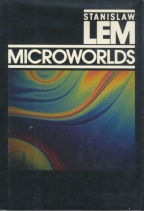 |
|
Stanislaw Lem's vituperative opinions and Cold War paranoia helped get him thrown out of the Science Fiction Writers of America. But in this collection of essays, I was introduced to the wonders of Philip K. Dick. |
|
|
|
(A Minority Opinion by a Bookaholic)
The Agony Column for Monday, June 24, 2002
Commentary by Rick Kleffel
When my wife and I were first married, the only TV we had was a small, malfunctioning color set that tended to fritz out and lose all but three colors -- pink, black and white. A complex technology of rubbery erasers inserted around the tuner knob often kept this in check. But it was vulnerable to very small children (including our own) who would find the erasers an irresistible attraction and remove them. We called it the pink and white TV, and I was fairly unconcerned as to the quality, since I was just entering the first giddy stages of a 20-year book-buying addiction. I had recently discovered that, being steadily employed and actually having a bit of disposable cash meant I could afford the $15 hardcover versions of newer books that I wanted. I was not forced to wait until books came out in paperback. I could satisfy the cravings immediately, forcibly, with hefty tomes that I could shelve in the living room. If only I had known where it would lead.
How could I have foreseen that 20 years later I would be viewing a movie version of a short story by one of my then favorite novelists with my two boys in the wide screen surround-sound equivalent of pink-and-white vision? No, there were no erasers beneath the screen at the multiplex yesterday. We're not quite to the level of interactive movies. Or should I say, we have not yet sunk to that level. But the bell is ringing and I can hear the Captain saying 'DIVE! DIVE!'
 |
|
Stanislaw Lem's vituperative opinions and Cold War paranoia helped get him thrown out of the Science Fiction Writers of America. But in this collection of essays, I was introduced to the wonders of Philip K. Dick. |
My interest in reading Philip K. Dick started as a result of one of my earliest hardcover book purchases, Stanislaw Lem's 'Microworlds'. This collection of essays about science fiction is an excellent primer in what NOT to do to get ahead in the world of American science fiction publishing. I don't have a pocket history of Lem at hand, but I do know that publication of essays such as 'Science Fiction: A Hopeless Case -- With Exceptions' didn't win Lem any friends in the world of 1980's American science fiction. In spite of producing such works as 'Solaris' and 'His Master's Voice', Lem never made much headway in the States. A combination of his curmudgeonly attitude and Cold War politics lead to his expulsion from the Science Fiction & Fantasy Writers of America. The writers who made their home in the land of free speech didn't take kindly to his blanket dismissal of all English SF since Wells as "philosophically uninteresting", and punted him on the grounds that he wasn't American.
Certainly, essays such as 'Philip K. Dick: A Visionary Among Charlatans' couldn't have had anything to do with it. But it was this essay which lead to a book-buying binge of epic proportions on my part. On Lem's recommendation, I gobbled up nearly 30 DAW and UK paperback version of Dick's novels. I also continued buying Lem's works as well. Twenty years later, both writers still retain their appeal for me. Alas, I can't say the same about the filmed versions of their work -- with exceptions.
 |
|
20 years and billions of special effects dollars later, and they still haven't topped this classic vision of the future. Maybe it had more to do with the vision part and less to do with the effects part. Could it be that art has a place even in movies? |
I'll cop to liking the 'Blade Runner' movie in whatever version, admit I didn't like the plot of the movie all that much when it first came out, admit I liked the vision enough to take my father who did not like SF movies to see this one, then duck and run. That movie didn't inspire the buying frenzy -- Lem did. I have to admit that I was not enthralled when I first heard that 'The Minority Report' was being made into a movie with Tom Cruise in the starring role. He didn't seem to be the correct physical type for the character from Dick's story, which begins: "The first thought that Anderton had when he saw the young man was: I'm getting bald. Bald and fat and old." But I was willing to suspend my disbelief.
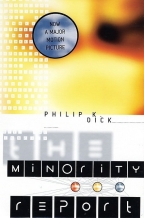 |
|
Those cool graphics will look like a soft drink adverisement in five years. Wait -- aren't they already a soft drink advertisement? |
Things didn't get any better, however, when the Publicity Department at Dreamworks released 'The Minority Report' as a book. I was pretty stoked when I first saw it. At least it wasn't a 'novelization'. No poor writer who might otherwise create something entertaining and original had been forced to prostitute him or herself to translate dialogue and descriptions into a 300-page 'novel'. Instead, the publisher had put together a fairly nice looking, smallish hardcover printing of the original story. The graphics on the cover were rather nice, and when I first saw it at the bookstore I was heartened. Someone had finally done something right.
Of course, reviewed as a novel by a leading national paper, 'The Minority Report' had been given poor marks. Mind you, this story is a mere 32 pages when printed in a normal format. It's a longish short story, but not a novel. Moreover, it's a Philip K. Dick short story, and as such, prone to the strengths and faults of such. As Lem points out in his essay on Dick in 'Microworlds', "Dick always moves among the typical trash of science fiction in the realm of androids, of the usual prophets ("precogs"), "psi", "esp"-fields, brain transplants and hundreds of other such similarly scurrilous products and phenomena." So it's little wonder that a major US paper, reviewing the release of a 32-page short story written 46 years ago would find it lacking as a novel. Of course it's lacking as a novel. It is in fact NOT a novel and never was a novel, and never will be a novel.
Alas, I'd have to concur with them, though not for the same reasons. That little book, so beautifully designed, and printed in a nice, large, readable font is printed at a 90-degree rotation from every other novel on the planet. It's like a little notebook, and practically impossible to read. I challenge anyone to read that book as printed and not get a combination of terminal wrist fatigue, carpal tunnel syndrome and 'hand-into-claw transfiguration' as seen in innumerable werewolf flicks. It's a disservice to the story and even the graphic design that the book is printed thus. Avoid this version of the story. It's a pretty good clue as to what you'll get when you see the movie, however.
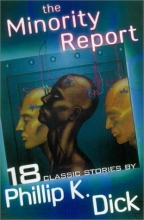 |
|
This is the latest version of 'The Collected Stories of Philip K. Dick, Volume 4'. When they make a movie of 'The Days of Perky Pat' (right), expect a new cover and title. I guess I can't begrudge them trying to make a buck off a book, though. |
Readers would do much better to pay the same price and get 18, count 'em 18 Philip K. Dick stories in 'The Collected Stories of Philip K. Dick, Volume 4', aka 'The Minority Report and Other Classic Stories'. In the latter, you'll get 'The Minority Report' and another classic Dick story 'The Days of Perky Pat'. If you really want to read some decent Dick writing, you'd be even better off with 'Ubik' or 'The Three Stigmata of Palmer Eldritch'. In these novels, you can see the purest distillation of Dick's vision. Then, if you can stand them, you might be ready for 'Valis' and his later work, a distillation so pure as to be potentially toxic to all but those interested in mental illness. Or not.
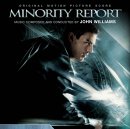 |
|
Yeah, it's a jpg of the soundtrack CD, but just pretend that it's a picture of the forthcoming DVD, which will be outmoded by the special edition of the DVD, and then the extra-special catering director's edition, complete with lunchbox, freeze-dried sandwich and a soft drink. Click on the soft drink image to find a special easter egg! |
Let's just hope that when they're turned into movies, we get something better than 'Minority Report'. From the casting of Cruise as Dick's old, fat, balding Everyman to the cheesy digital special effects that look a bit better than Gamecube, this movie is a sleeper in the sense that I actually had to start myself awake during the stretches when I wasn't wondering if the grainy, washed out cinematography was going to give me a migraine. I must admit that there were a few touches near the beginning that gave me hope. Some of the details evoked by Cruise's performance (when you can see it), and the complexity of the Dick's ideas parlayed into a feature length screenplay of higher-than-average intelligence gave me hope that we might see something that was better than 'Screamers', an under-rated tobacco company advertisement starring Peter Weller. But by the time Cruise as Anderton was on the run with the sexy psychic played by Samantha Morton, I'd used up my parenting-honed reservoir of patience. There are certainly a lot of interesting ideas banging about in the two hours of 'Minority Report', but they're nothing you can't find more clearly and cleanly expressed in his stories and novels. Read something instead. I'm betting that advice will come as a big surprise. I will admit that I'm currently 'Lost In A Good Book' by Jasper Fforde. It would be very hard for any movie to compete with it.
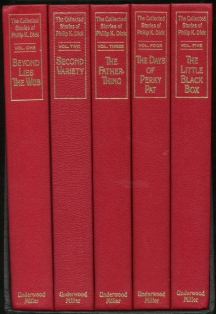 |
|
Now here's a manly edition of Philip K. Dick. Ghoulish as well, as the signature is a sipped in signature from a canceled check. The sum total of money that Philip K. Dick made from all his writing in his lifetime would not buy the hair-poofing materials used in the latest film adaptation. |
For example, the total cost of seeing this movie and having lunch with the boys was $40.00. For a mere 20 times this amount, you can score a copy of the limited edition of Philip K. Dick's five-volume 'Collected Stories' from the legendary publishers at Underwood Miller. You'll have to run a book search, but to my mind this is money much better spent. Or for say for $60 you could simply buy all five trade paperbacks containing the same stories. Your call. In any case, it's money much better spent. You'll end up with a collection of writing that will last for years of nightstand reading, and a few extra aspirin for when your children exhaust that parental patience reservoir.
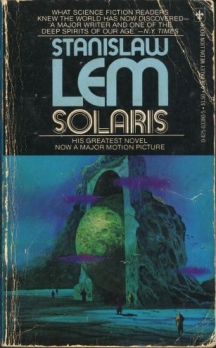 |
|
Note that the 'major motion picture' referred to in this edition is Tarkovsky's three-hour series of static images, suitable only for the truly patient. Take a guess as to when this mass market paperback was published and purchased. |
The coda to all this actually came before the movie, when I saw a "teaser trailer" for the forthcoming Stephen Soderbergh adaptation of Lem's 'Solaris'. I'll have some reviews of Lem's best novels as the summer progresses and I go on a binge of re-reading, including 'His Master's Voice', 'The Investigation' and 'The Chain of Chance'. It was, after all Stanislaw Lem who brought me to Philip K. Dick, in spite of Lem's trash talk. Unfortunately, from an early interview with the director, it sounds like another SF classic is headed for the gutting board. 'Solaris' is a novel of ideas and the satire of ideas. The director's take on his movie is that it is going to be "'2001' meets 'Last Tango in Paris'". I understand that movies and books are essentially very different formats with different requirements. Tarkovsky's 'Solaris' is certainly no verbatim adaptation, and has its own problems, primary among them the director's style. If you like it, you can sit through anything he's done. If you don't like it, you're likely to hate it. I'll count myself a Tarkovsky fan. He's adapted Lem and the Strugatsky brothers' classic 'Roadside Picnic' (as 'Stalker'). Though he's made substantial changes to both novels to force them to fit his own style of direction, he's at least consistently chosen good source material. Not that I wouldn't love to see a much more faithful adaptation of 'Roadside Picnic'. If the movie version of 'Solaris' does well, it wouldn't surprise me if someone took another stab 'Roadside Picnic'.
In the end, however, I think I'll opt for re-reading the books.
Thanks,
Rick Kleffel